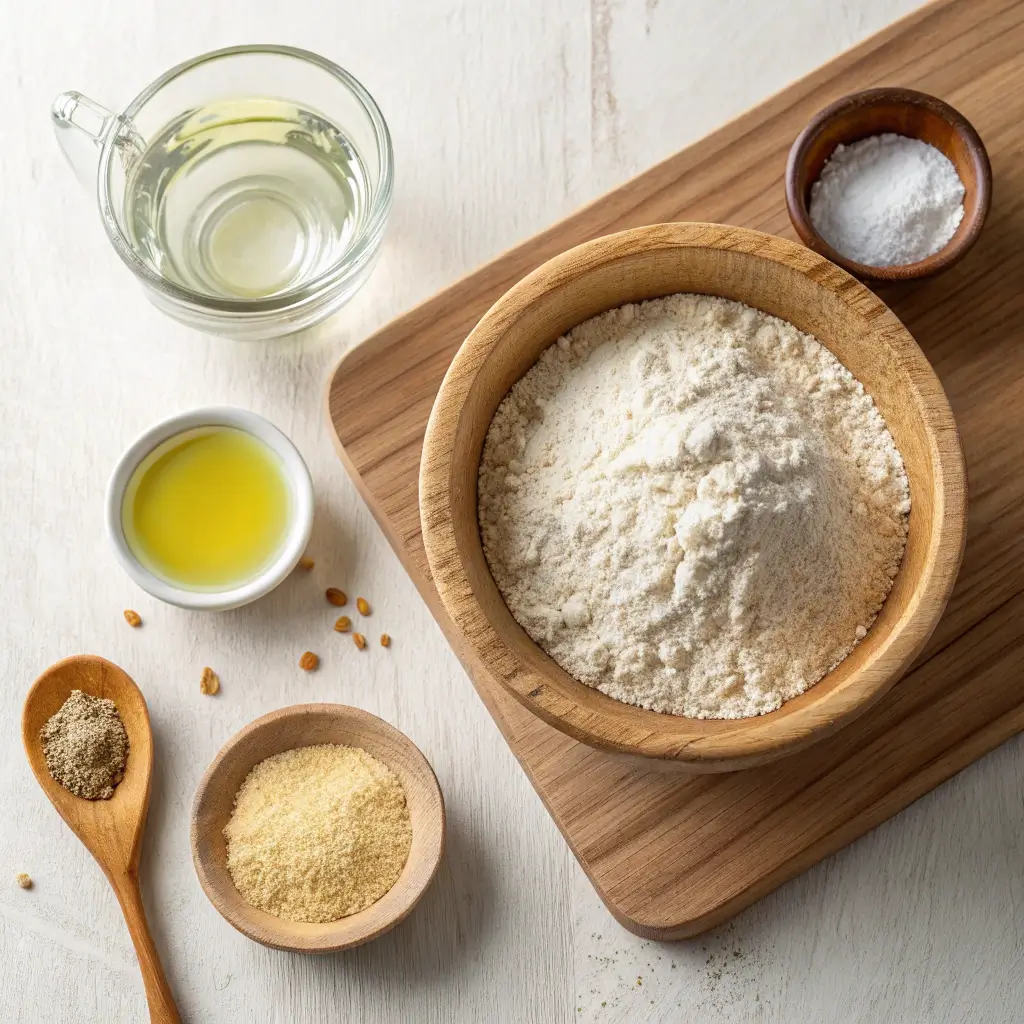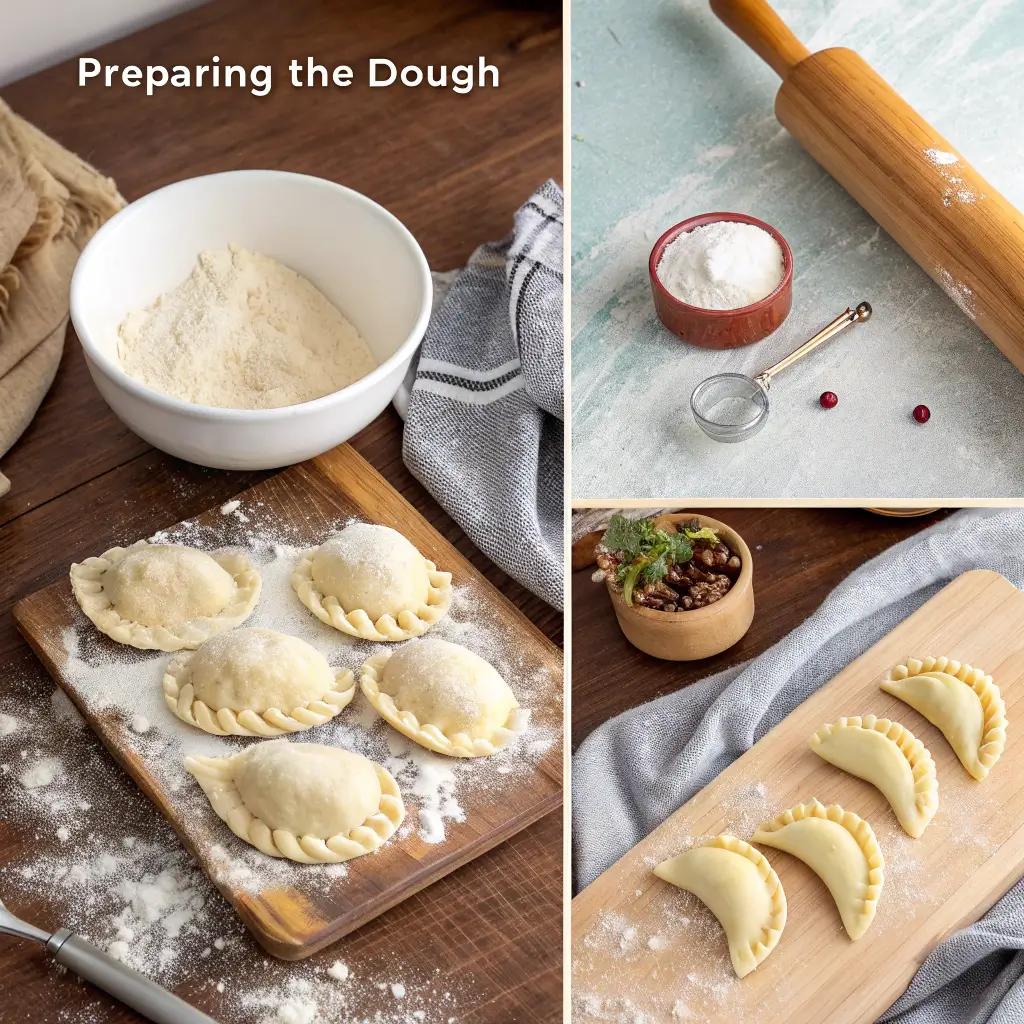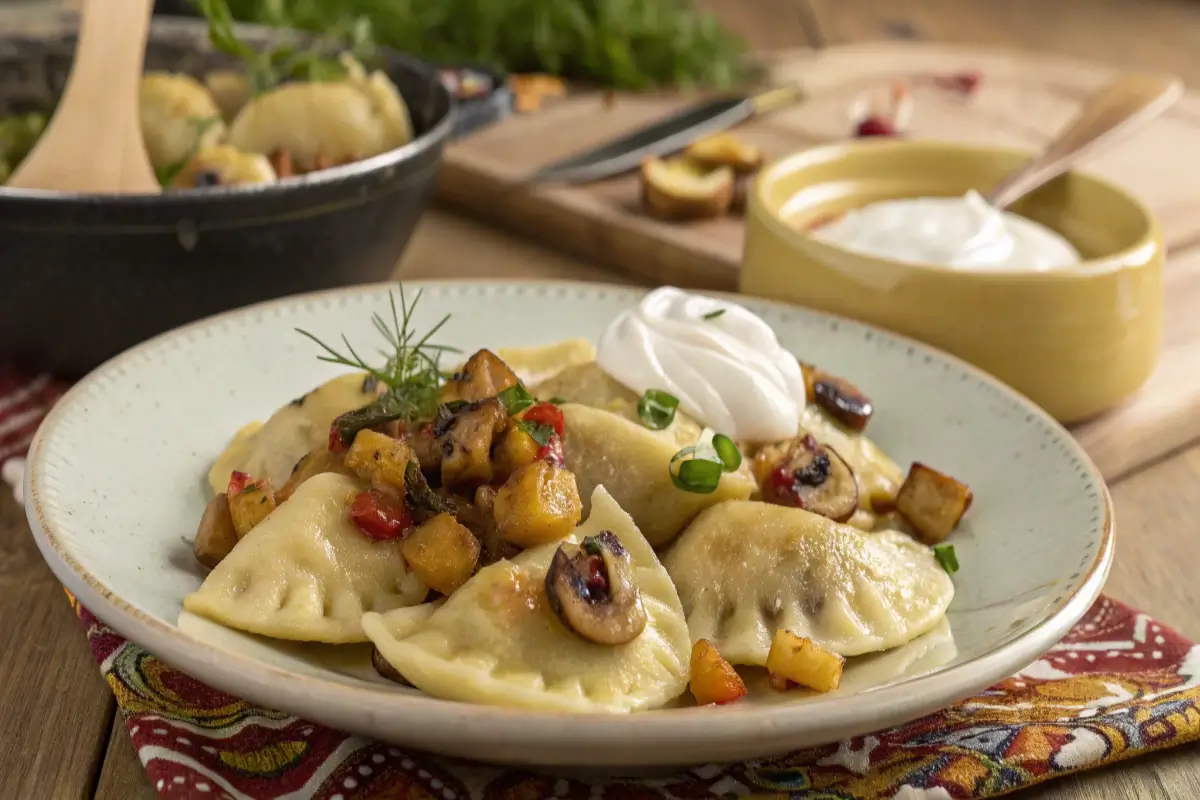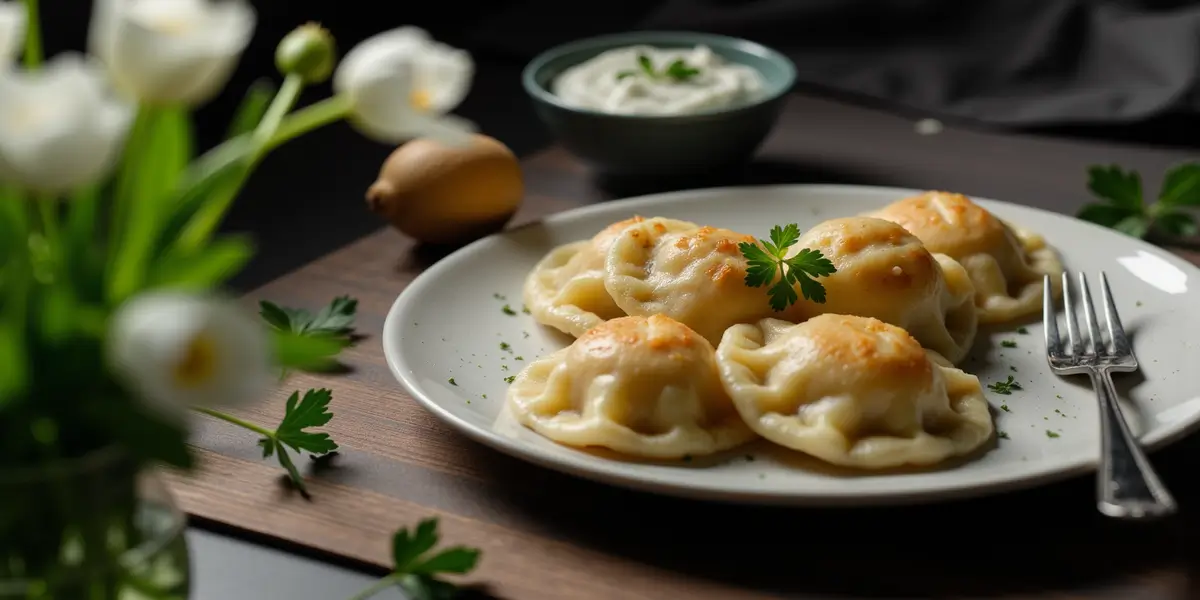Who says you have to give up traditional pierogi when following a gluten-free or plant-based diet? With this gluten free pierogi recipe, you can enjoy the soft, pillowy texture and delicious fillings of this beloved dish—all without wheat, dairy, or eggs!
Whether you crave the classic potato and onion filling, a savory mushroom and sauerkraut twist, or a sweet blueberry variation, this recipe is completely customizable to suit your taste. The gluten-free dough is easy to work with, stretchy, and holds together beautifully, making it perfect for both beginners and experienced home cooks.
These vegan and gluten free pierogi are not only comforting and satisfying but also made with wholesome, plant-based ingredients. Ready to make your own homemade pierogi without gluten or animal products? Let’s dive in and create the best gluten free pierogi you’ve ever tried!
Why You’ll Love This Gluten Free Pierogi Recipe
Pierogi are a staple of Polish cuisine, loved for their pillowy-soft dough and flavorful fillings. But if you’re following a gluten-free or plant-based diet, traditional pierogi can seem off-limits. Thankfully, this gluten free pierogi recipe captures the authentic taste and texture you love—without the gluten, dairy, or eggs! Whether you’re making them for a special occasion or a cozy homemade meal, these easy, customizable pierogi will become a new favorite in your kitchen.
Traditional Taste, Without the Gluten
One of the biggest challenges of making gluten free pierogi is achieving a soft, pliable dough that mimics the traditional wheat-based version. This recipe uses a carefully balanced blend of gluten-free flours, ensuring the pierogi hold their shape while maintaining that classic tender bite.
- Authentic flavor without wheat-based flour.
- No compromise on texture—they’re just as soft and satisfying as the original.
- Perfectly pairs with traditional toppings like caramelized onions, dairy-free sour cream, or fresh herbs.
Soft, Stretchy Dough That Works Every Time
Gluten-free dough can sometimes be fragile and prone to cracking, but this recipe ensures a stretchy, easy-to-work-with dough that won’t fall apart during rolling or shaping. Here’s why it works:
- Xanthan gum or psyllium husk creates elasticity, mimicking gluten’s binding effect.
- The right mix of gluten-free flours (like rice flour, potato starch, and tapioca starch) ensures softness.
- A short resting time helps the dough become more flexible for rolling and shaping.
With these simple techniques, you’ll get a smooth, workable dough that won’t break or tear, making the process stress-free and fun!
Customizable Fillings for Every Diet
One of the best things about homemade pierogi is the ability to customize the filling to suit your taste and dietary needs. Whether you prefer savory or sweet, there are plenty of vegetarian and vegan-friendly options to try:
- Classic Potato & Onion – Creamy mashed potatoes mixed with sautéed onions.
- Mushroom & Sauerkraut – A tangy, umami-rich filling perfect for traditional pierogi lovers.
- Lentil & Caramelized Onion – A protein-packed alternative with a deep, savory flavor.
- Vegan Sweet Pierogi – Filled with blueberries, apples, or cinnamon-spiced mashed sweet potatoes.
With these versatile filling options, you can make a batch of pierogi that suits everyone at the table. Whether you go for a hearty savory version or a dessert-style pierogi, this recipe offers endless possibilities for a delicious, plant-based meal.
Now that you know why this gluten free pierogi recipe is a game-changer, let’s move on to the key ingredients that make it all possible!
Essential Ingredients for Gluten Free Pierogi Dough
Creating the perfect gluten free pierogi dough requires a careful selection of flours, binders, and dairy-free alternatives to achieve the soft, stretchy texture of traditional pierogi. Unlike wheat-based dough, which naturally holds together, gluten-free dough needs the right combination of ingredients to be pliable, easy to roll, and resistant to cracking. Here’s how to make the best gluten-free, vegan-friendly pierogi dough every time.

Best Gluten-Free Flour Blends for Pierogi
Choosing the right gluten-free flour blend is key to achieving soft, pillowy dough that won’t fall apart. Since gluten provides elasticity, replacing it requires a mix of flours and starches to get the ideal consistency. Here’s what works best:
- Rice Flour (White or Brown) – The base for a light yet structured dough.
- Potato Starch – Adds softness and a slightly chewy texture, making the dough more flexible.
- Tapioca Starch or Arrowroot Flour – Improves elasticity and helps prevent cracking.
- Cornstarch or Sweet Rice Flour – Works as a secondary binder for extra pliability.
For the best results, use a pre-made gluten-free flour blend that contains a mix of these ingredients, or create your own by combining them in the right proportions.
Binding Agents: Xanthan Gum or Psyllium Husk?
Without gluten, the dough needs a binder to hold it together and provide stretchiness. Two of the best options are:
- Xanthan Gum – A common gluten substitute that mimics the elasticity of wheat-based dough. It keeps the dough flexible and prevents it from breaking apart.
- Psyllium Husk Powder – Absorbs moisture and adds a more bread-like, flexible texture, making it a great alternative to xanthan gum.
👉 Which one to use? If you prefer a smooth, elastic dough, xanthan gum works well. If you want a slightly softer, chewier dough, psyllium husk is a great choice. Both can be used, but only one is needed per recipe to prevent the dough from becoming too dense.
Dairy-Free & Vegan Substitutes
Traditional pierogi dough contains milk, eggs, and butter, but making it vegan-friendly is simple with the right swaps:
- Milk Substitute: Use unsweetened plant-based milk (almond, oat, or soy) or simply replace it with warm water for a neutral dough.
- Egg Substitute: Instead of eggs, olive oil or additional psyllium husk can help create structure while keeping the dough pliable.
- Butter Substitute: Swap dairy butter with vegan butter or coconut oil, both of which add richness to the dough without affecting texture.
With these simple gluten-free and vegan ingredient swaps, you’ll have a stretchy, easy-to-work-with pierogi dough that’s just as delicious as the traditional version.
Now that we’ve covered the essential ingredients, let’s move on to the step-by-step guide to making your perfect gluten free pierogi from scratch!
Step-by-Step Guide to Making Gluten Free Pierogi
Making gluten free pierogi from scratch may seem tricky, but with the right techniques, you can achieve soft, delicious dumplings that hold their shape and taste just like the traditional version. Follow this step-by-step guide to ensure your gluten-free and vegan pierogi turn out perfectly every time!
1. Preparing the Dough: Mixing, Kneading & Resting
Handling gluten-free dough requires a slightly different approach than regular wheat-based dough. Here’s how to get the best results:
- Mix the dry ingredients – In a large bowl, combine gluten-free flour blend, xanthan gum (or psyllium husk), and a pinch of salt.
- Add wet ingredients – Pour in warm water or unsweetened plant-based milk and melted vegan butter or olive oil. Mix until the dough starts to come together.
- Knead gently – Since gluten-free dough is more delicate, knead it lightly for 2-3 minutes until it forms a smooth ball. Avoid over-kneading, as it can make the dough too dry.
- Rest the dough – Cover the dough with a damp towel and let it rest for 30 minutes. This allows the flour to absorb the moisture, making it more pliable and easier to roll.
💡 Pro Tip: If the dough feels too sticky, dust it with a little extra gluten-free flour. If it’s too dry, add a teaspoon of water or oil at a time until it becomes soft and flexible.
2. Making the Perfect Filling: Traditional & Vegan Options
The filling is just as important as the dough! Here are some delicious gluten-free, vegan-friendly options:
- Classic Potato & Onion (Vegan Option) – Mashed potatoes mixed with caramelized onions, seasoned with salt and pepper for a creamy, comforting filling.
- Mushroom & Sauerkraut – A tangy and umami-rich option made with sautéed mushrooms and finely chopped sauerkraut.
- Lentil & Caramelized Onion – A high-protein alternative using mashed lentils and sweet caramelized onions.
- Sweet Pierogi (Blueberry or Apple-Cinnamon) – A dessert-style filling using fresh or cooked fruit with a touch of maple syrup and cinnamon.
💡 Pro Tip: Keep the filling smooth and well-mashed to prevent any lumps from tearing the dough when shaping the pierogi.
3. Shaping and Sealing the Pierogi
Once the dough is rested and the filling is ready, it’s time to shape the pierogi:
- Roll out the dough – Lightly dust a surface with gluten-free flour and roll out the dough to about ⅛ inch (3 mm) thick.
- Cut out circles – Use a round cookie cutter or glass to cut out circles of dough (around 3 inches in diameter).
- Fill each pierogi – Place a small spoonful of filling in the center of each circle. Be careful not to overfill, as this can cause the pierogi to break when sealing.
- Seal the edges – Fold the dough over the filling to create a half-moon shape. Press the edges firmly together, then pinch or use a fork to create a decorative seal.
💡 Pro Tip: If the edges don’t stick, lightly brush them with water before sealing.
4. Boiling and Pan-Frying for the Best Texture
Cooking pierogi correctly ensures they have the perfect balance of softness and crispiness.
- Boiling Method (Essential Step):
- Bring a large pot of salted water to a boil.
- Drop in the pierogi and stir gently to prevent sticking.
- Once they float to the top (about 3-5 minutes), let them cook for 1 more minute, then remove with a slotted spoon.
- Pan-Frying for Extra Flavor:
- Heat a pan over medium heat with a little vegan butter or olive oil.
- Fry the boiled pierogi until golden brown and crispy on both sides (about 2-3 minutes per side).
- Serve with dairy-free sour cream, caramelized onions, or fresh herbs.
💡 Pro Tip: If making sweet pierogi, pan-fry them in a little coconut oil and sprinkle with cinnamon and maple syrup for a delicious dessert!

Now you’re ready to enjoy homemade gluten free pierogi with perfectly soft dough and delicious fillings. Next, let’s explore how you can customize your pierogi with different flavors and variations!
Customizing Your Gluten Free Pierogi with Different Fillings
One of the best things about homemade gluten free pierogi is how versatile and customizable they are. Whether you prefer savory, sweet, or protein-packed options, there’s a perfect filling to suit your taste. Below are some delicious gluten-free and plant-based variations to try!
Savory Options: Potato, Onion, Sauerkraut & Mushrooms
For those who love traditional Polish flavors, these classic fillings bring comfort and rich taste to your pierogi:
- Potato & Onion – The most popular filling, made with creamy mashed potatoes and caramelized onions for a rich, buttery taste.
- Sauerkraut & Mushrooms – A tangy and earthy combination, featuring fermented sauerkraut and sautéed mushrooms for a bold umami flavor.
- Garlic & Herb Mashed Potatoes – A twist on the classic, adding roasted garlic and fresh herbs for extra depth of flavor.
💡 Pro Tip: Add a little nutritional yeast to the potato filling for a hint of cheesy flavor without dairy!
Sweet Pierogi: Blueberry, Apple, and Cinnamon Variations
Not all pierogi have to be savory! Sweet pierogi make a delicious dessert or a fun breakfast option.
- Blueberry Pierogi – Filled with fresh or mashed blueberries mixed with a touch of maple syrup, these are naturally sweet and vibrant.
- Apple-Cinnamon Pierogi – A warm, cozy filling made with sautéed apples, cinnamon, and a splash of vanilla.
- Sweet Potato & Coconut – A creamy, tropical twist combining mashed sweet potatoes with shredded coconut and a touch of agave.
💡 Pro Tip: Serve sweet pierogi with a dusting of cinnamon, a drizzle of maple syrup, or dairy-free yogurt for extra indulgence.
High-Protein Fillings: Lentils, Tofu, and Dairy-Free Cheese
If you want a more nutritious, protein-packed pierogi, try these hearty and plant-based filling ideas:
- Lentil & Caramelized Onion – Cooked lentils mixed with sweet caramelized onions for a protein-rich, savory bite.
- Tofu & Spinach – A creamy yet light filling using crumbled tofu, sautéed spinach, and garlic, perfect for a nutrient boost.
- Dairy-Free Ricotta & Herbs – A plant-based alternative using blended cashews or almond ricotta, flavored with fresh basil or dill.
💡 Pro Tip: Add a bit of miso paste or nutritional yeast to the tofu-based fillings to give them a deeper, savory flavor!
Spicing It Up: Herbs and Seasonings for Extra Flavor
To elevate your pierogi and make them stand out, consider using a blend of herbs and spices:
- Dill & Chives – Classic Polish flavors that enhance both potato and mushroom fillings.
- Smoked Paprika & Cumin – Adds warmth and depth, great for lentil or tofu fillings.
- Thyme & Nutmeg – Perfect for savory or sweet fillings, adding a subtle, aromatic touch.
- Lemon Zest & Vanilla – Brightens up sweet pierogi, especially blueberry or apple-based variations.
💡 Pro Tip: Try roasting your vegetables with herbs before adding them to the filling for a richer, more developed flavor.

Conclusion
Making gluten free pierogi at home is not just about recreating a classic dish—it’s about enjoying better texture, fresher ingredients, and complete customization. Unlike store-bought versions, which can be dry, tough, or loaded with preservatives, homemade pierogi are soft, flavorful, and made with real, wholesome ingredients. Plus, when you make them from scratch, you can tailor the dough and fillings to your preferences, ensuring they’re vegan, dairy-free, and perfectly suited to your taste.
One of the best parts of this recipe is its versatility. Whether you love the comfort of traditional potato and onion pierogi, the tangy kick of sauerkraut and mushrooms, or a sweet and fruity twist with blueberry or apple fillings, there’s a variation for every craving. Don’t be afraid to get creative—experiment with different flours, spices, and toppings to make your pierogi truly unique.
If you enjoyed this gluten free pierogi recipe, be sure to explore other gluten-free and plant-based recipes on the blog! From homemade gluten-free pasta to dairy-free desserts, there are plenty of delicious and comforting meals waiting for you. Happy cooking!
Frequently Asked Questions (FAQ)
What is the best flour for gluten free pierogi dough?
The key to a soft and stretchy gluten free pierogi dough is using the right blend of gluten-free flours and starches. The best combination includes:
Rice flour (white or brown) – Provides structure and a neutral flavor.
Potato starch – Adds softness and mimics the texture of wheat-based dough.
Tapioca starch – Improves elasticity and helps prevent cracking.
Xanthan gum or psyllium husk – Acts as a gluten replacement to create a pliable, non-crumbly dough.
💡 Pro Tip: If using a pre-made gluten-free flour blend, make sure it contains starches and binders to ensure the dough stays together. Avoid blends that are too high in bean flour, as they can make the dough too dense.
Can I make these pierogi dairy-free or vegan?
Yes! This recipe is naturally vegan and dairy-free, so you won’t need to make substitutions. However, if you’re adapting another pierogi recipe, here’s what you can use:
Milk substitute: Unsweetened almond, soy, or oat milk, or simply warm water.
Butter substitute: Vegan butter or coconut oil for richness.
Egg substitute: No eggs are needed! Olive oil or psyllium husk helps bind the dough.
Cheese alternative: Dairy-free ricotta, cashew cheese, or nutritional yeast for a creamy filling.
💡 Pro Tip: If making savory vegan pierogi, try miso paste or nutritional yeast for extra umami flavor!
How do I prevent my gluten-free dough from cracking?
Gluten-free dough is naturally more fragile, but you can prevent cracking by following these tips:
Hydrate properly: If the dough feels dry, knead in a teaspoon of water or oil at a time.
Let it rest: Cover and let the dough rest for 30 minutes to allow moisture to absorb evenly.
Roll gently: Use light pressure when rolling the dough—too much force can cause tearing.
Seal edges well: If the edges don’t stick, lightly brush them with water or plant-based milk before sealing.
💡 Pro Tip: If your dough cracks while shaping, press it back together with slightly damp fingers to smooth out the surface.
What’s the best way to store and freeze gluten free pierogi?
Storing and freezing gluten free pierogi properly ensures they stay fresh and maintain their texture.
Refrigerating: Store cooked pierogi in an airtight container for up to 3 days. Reheat by pan-frying or steaming to restore texture.
Freezing uncooked pierogi: Place shaped pierogi in a single layer on a parchment-lined tray.
Freeze for 1-2 hours until firm, then transfer to a freezer-safe bag or container.
Store for up to 3 months.
Cooking from frozen: Boil directly from frozen—do not thaw first, as they may become sticky.
💡 Pro Tip: Label your frozen pierogi with the filling type and date so you can easily pick your favorite when cooking!
With these expert tips, you’ll be able to make perfect gluten free pierogi every time! Ready to enjoy your homemade pierogi? Let’s wrap things up with some final thoughts and inspiration for your next batch.
___________________________________

The Best Gluten Free Pierogi Recipe You Must Try
Ingredients
Dough Ingredients:
- 1 ½ cups gluten-free flour blend with rice flour, potato starch, tapioca starch
- 1 tsp xanthan gum or psyllium husk for elasticity
- ½ tsp salt
- ½ cup warm water or plant-based milk
- 1 tbsp olive oil or melted vegan butter
Filling Options:
🟢 Savory Fillings:
- Potato & Onion: 1 cup mashed potatoes + ½ cup caramelized onions
- Sauerkraut & Mushrooms: ½ cup sautéed mushrooms + ½ cup sauerkraut
- Lentil & Caramelized Onion: ½ cup cooked lentils + ½ cup caramelized onions
🔵 Sweet Fillings:
- Blueberry: ½ cup mashed blueberries + 1 tbsp maple syrup
- Apple-Cinnamon: ½ cup diced apples + ½ tsp cinnamon + 1 tbsp maple syrup
Instructions
Prepare the Gluten-Free Dough
- In a bowl, whisk together gluten-free flour, xanthan gum, and salt.
- Add warm water and olive oil, mixing until a soft dough forms.
- Knead lightly, then cover and rest for 30 minutes to allow the flour to hydrate.
Make the Pierogi Filling
- Prepare your chosen savory or sweet filling.
- Mash or finely chop ingredients to ensure a smooth, even consistency.
Roll and Shape the Pierogi
- Lightly flour a work surface and roll out the dough to about ⅛ inch thick.
- Cut out circles using a cookie cutter or glass (~3 inches in diameter).
- Add 1 teaspoon of filling to each circle.
- Fold in half, sealing the edges by pressing firmly or crimping with a fork.
Cook the Pierogi
- Boiling: Bring a large pot of salted water to a boil. Drop in pierogi and cook until they float to the surface (~3-5 minutes).
- Pan-Frying (Optional): Heat a pan with vegan butter or oil and fry until golden brown.
Serve and Enjoy!
- Garnish with dairy-free sour cream, caramelized onions, or fresh herbs.
- For sweet pierogi, drizzle with maple syrup or cinnamon sugar.
Notes
- Calories: ~220 kcal
- Carbohydrates: 40g
- Protein: 5g
- Total Fat: 5g
- Saturated Fat: 1g
- Fiber: 3g
- Sugar: 2g
- Sodium: 150mg

